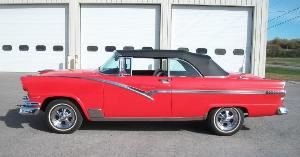|
Group: Forum Members
Last Active: 4 Years Ago
Posts: 192,
Visits: 39.2K
|
If I connected 2 6v batteries in series I could use both batteries (12) volts for starting. A 12v alternator to charge the batteries. NOW you tap off in the middle of this battery "system" for 6 volts to handle the 55 bird. The dilemma comes in with "positive" ground for the bird. You can change it to 6v neg. gnd. 12v starter would be neg. gnd. A light bulb will glow with current in either direction. The only accessory that needs correct polarity is the radio. Just a thought. This is known as "tuning for maximum smoke". Probably just cheaper to go all 12v.
|
|
Group: Forum Members
Last Active: Last Month
Posts: 3.7K,
Visits: 32.6K
|
Florida Phil's T-Bird was 12 Volt POSITIVE Ground when He got it. Successfully switched it to 12 Volt Neg. Ground other than the Radio as far as I know. Maybe He -can give You some Info. 6 Volt Starter doesn't care if its + or- and it will last for awhile on 12 Volts.
 
|
|
Group: Forum Members
Last Active: 2 days ago
Posts: 562,
Visits: 8.3K
|
I don't see any advantage to changing to 12 volts. A good 6 volt system will out preform a 12 volt system (more amps, less chance of plugs fouling,because of hotter spark)
|
|
Group: Forum Members
Last Active: Yesterday
Posts: 3.6K,
Visits: 497.7K
|
I disagree - but I don't want to go into the number of things that makes a 12 volt system better. Ponder this - if a 6 volt system is better, why did all the manufacturers go to 12 volts? Lou (6/4/2018)
I don't see any advantage to changing to 12 volts. A good 6 volt system will out preform a 12 volt system (more amps, less chance of plugs fouling,because of hotter spark)
54 Victoria 312; 48 Ford Conv 302, 56 Bird 312
Forever Ford
Midland Park, NJ
|
|
Group: Forum Members
Last Active: 2 Years Ago
Posts: 131,
Visits: 542.7K
|
The original '55 six volt radio will work with either positive or negative ground. So will a '56 twelve volt radio. It is a characteristic of the vibrator power supply. '57 and later will not because of the introduction of using transistors. You must still use the original mechanical vibrator, the solid state vibrators of today are polarity sensitive. Check with the vendor of the modern day solid state vibrators they may offer a 6 volt version with reverse polarity.
|
|
Group: Forum Members
Last Active: Last Month
Posts: 1.9K,
Visits: 194.9K
|
I’m not going to address the 6-12 volt issue. For me it’s the added accessories that made 12 volts attractive.
For years we ran a 32 volt system on the boat-4 8 volt batteries tied together. We had taps at 16v and 24v for other items.
As long as the main loads were 32 volt, it worked fine. But if you ran down 2 batteries at 16, you could get into and over/under charging problem on the 2 batteries that didn’t see the load. It had a 32 volt charging system.
If I were going to run 2 6’s, I’d move at least the headlight and probably the ignition to the 12 volt side. Or more likely everything but the gauges, dash lights, and turn/parking. At this point, you’ve got to wonder if it worth the effort to run 2 voltages instead of a drop resistor, and a radio adaptor. I think they still make those.
miker
55 bird, 32 cabrio F code
Kent, WA
Tucson, AZ
|
|
Group: Forum Members
Last Active: 2 days ago
Posts: 562,
Visits: 8.3K
|
Paul, Ford went to 12 volt system because it was cheaper, lighter wire, cheaper starters and generators. That combined with several other changes in trim and production (there are 2 less springs in the seats of a 56 Ford than a 55) enabled Ford to build the 56 Ford $12,00 cheaper than a 55 Ford model by model. Times that by the Million and Haft 56 Fords produced and it gives new meaning to a penny saved is a penny earned.
|
|
Group: Forum Members
Last Active: 3 Years Ago
Posts: 513,
Visits: 153.3K
|
paul2748 (6/4/2018)Ponder this - if a 6 volt system is better, why did all the manufacturers go to 12 volts?
Because high output, high compression large cubic inch displacement engines were the rage, coupled with with the advent of an array of new power hungry electrical accessories becoming affordable albeit extra cost options or even standard equipment. The fact that lighter gauge cables and wiring could be used was just an added bonus.
|
|
Group: Forum Members
Last Active: Yesterday
Posts: 3.6K,
Visits: 497.7K
|
Tedster got it right. That was what I was trying to get across. Also, 12 volts require less amperage to operate the electrical system Lou (6/4/2018)
Paul, Ford went to 12 volt system because it was cheaper, lighter wire, cheaper starters and generators. That combined with several other changes in trim and production (there are 2 less springs in the seats of a 56 Ford than a 55) enabled Ford to build the 56 Ford $12,00 cheaper than a 55 Ford model by model. Times that by the Million and Haft 56 Fords produced and it gives new meaning to a penny saved is a penny earned.
54 Victoria 312; 48 Ford Conv 302, 56 Bird 312
Forever Ford
Midland Park, NJ
|
|
Group: Forum Members
Last Active: Last Year
Posts: 257,
Visits: 3.9K
|
Some 50+ years ago I was young, married, with a new family and had a '55 Crown that I had put a '57 312 (ECZ-G heads, 1.54 rockers, factory H. O. cam, etc.) into. The 6-volt system just would not handle reliable start cranking in NE MN at -30 F winter temps and I needed reliable start to get to and from work. I cobbled two of the Ford starter solenoids together in tandem ("top to bottom") and used two 6-volt batteries which would start at 12 V (in series) JUST for start, then revert to parallel for 6 V run/charge.(never 12 V to any bulbs or accessories!).
Semi-truck dealers of that era had commercially-available factory-made equivalents of what I had cobbled together for the expensive (for that time) price of about $32.00 - which we could not afford - that was almost a half-week's wages "starting-pay" then. Those "series/parallel" starter solenoids may still be available - research it: The solenoid coil needs to be rated at 6 Volts for your application. And, this type of situation will require two additional battery cables of appropriate gauge, length, and terminal connections for your specific physical battery layout arrangement.
My "cobble" used two of the "later" Ford bakelite-case solenoids with both the "I" and "S" auxilliary connections, and added one additional "auxilliary" contact on each for "top" contact connections on each to obtain the "parallel" run/charge battery connections when the solenoid was not energized for "start": They were automatically disconnected when the solenoids were "pulled-in" for start. One was a full casing & one with the bottom end-cap cut off, solenoid coil removed & top metal cover rivets removed - then "stacked" the two solenoid "barrels" together with drilled, tapped, and used a screw shank to attach together with the partial case on top of the "whole" one.
It went together with four small bolts through all eight case holes. Only the "bottom" 6 volt solenoid coil was used. Then battery cables were arranged in such a way that when de-energized, the batteries were in parallel, with both in series to the starter only during cranking and all accessories, bulbs, etc., tapped from the permanently-grounded one of the two batteries; the second battery was the one to be "switched" to "in series" to the starter only during cranking; otherwise, it was in parallel with the "grounded" one under all other conditions - thus, was charged during normal running operation and/or if using a battery charger with the motor off or running.
In my experience, the 6 Volt starter had no issues being cranked by 12 Volts; though, others here have indicated having had 6 V starter "issues" using their 12 V conversion.
My current Crown (different car) was "converted" (very poorly) to 12 V before i got it: I have since modified the 6 Volt clock, radio, and gauge circuits to run on the 12 V system. I re-wound the clock "winding" electro-magnets for a straight 12 volts, got ahold of a "bad" (unrepairable) '56 radio and changed-out the vibrator, tubes, dial light, and internal inverter transformer from the '56 to the '55 (those are the only differences between the equivalent '55's and '56's; and are relatively easy to do with some electronics' knowledge).
I also added an appropriate series resistor into both the fuel and temperature gauge circuits: this is more "complicated", and should be done by more "technically competent" electronics folks (measure the "open circuit" resistance of the whole circuit from the disconnected "accessories" circuit connection at the gauge "Acc." terminal back to the engine "ground" for the temp. and back to the fuel tank "ground" for the fuel gauge. Each circuit should measure a different resistance. In my case, my fuel circuit measured 35 ohms "open-circuit / cold": I added a 35 ohm power resistor in series between the gauge and fuel sender back at the sender (so as to "hide" the resistor under the in-trunk fuel sender access hole cover). At 35 ohms and 6 volts, the original circuit current is about 0.17 amps [6 divided by 35] and dissipates about 1 watt of power [6 X 0.17]; I used a 5-watt resistor to assure resistor heat dissipation at a relatively low temperature (I could have "gotten-by" with a 1 watt resistor; but, it would have run "hot"; and, I don't like "hot" near any fuel tank!)
Same scenario holds for the temp. gauge system for which I don't remember the resistor size nor power rating: Again, measure and match resistance; and, calculate wattage for the MINIMUM resistor wattage rating. I'd recommend this resistor be placed in the engine compartment as a guard against resistor "heat" under the dash - though, with some spacing care, it could be installed near the gauge - keeping "heat" in mind so as to not melt wire insulation or start a fire.
Hope this may help someone with this situation.
Regards, JLB
55 Ford Crown Victoria Steel Top
|